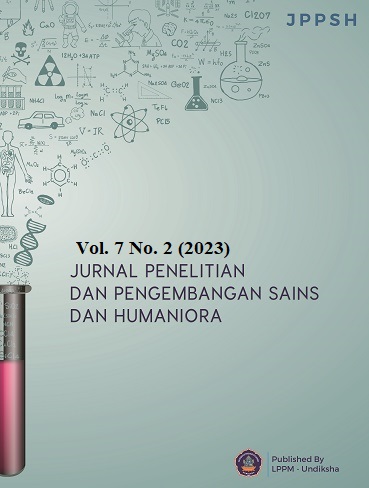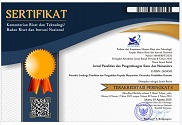Poverty and Frustration as Predictor of Domestic Violence among Sandwich Students
DOI:
https://doi.org/10.23887/jppsh.v7i2.67813Keywords:
Poverty, Frustration, Domestic Violence, Sandwich StudentAbstract
The prevalence of domestic violence in Nigeria remains alarmingly high, exhibiting no discernible indications of decline. Prevalence of this phenomenon is observed among couples irrespective of their age, ethnic background, religious affiliation, or socioeconomic standing. This study aims to investigate the relationship between poverty and dissatisfaction as predictors of spousal violence among sandwich students. The research employed a descriptive design of the ex-post-facto kind. A multi-stage selection procedure was employed to pick a sample of 120 respondents from three departments. The participants were assessed using appropriate standardized measures (instruments) and the collected data were subjected to statistical analysis utilizing the percentage and Pearson Product Moment Correlation (PPMC) and Multiple Regression techniques at a significance level of 0.05. Hence, in light of the research indicating a significant correlation between poverty and domestic violence, it is suggested that counseling professionals and psychologists should enhance their endeavors to organize seminars for student couples.
References
Abbas, J. (2021). Crisis management, transnational healthcare challenges and opportunities: The intersection of COVID-19 pandemic and global mental health. Research in Globalization, 3, 100037. https://doi.org/10.1016/j.resglo.2021.100037.
Ahmad, A., Mahmood, Q. K., Saud, M., & Mas’udah, S. (2019). Women in Democracy: The Political Participation of Women. Masyarakat, Kebudayaan Dan Politik, 32(2), 114–122. https://doi.org/10.20473/MKP.V32I22019.114-122.
Ali, F., & Kramar, R. (2015). An exploratory study of sexual harassment in Pakistani organizations. Asia Pacific Journal of Management, 32(1), 229–249. https://doi.org/10.1007/s10490-014-9380-1.
Aristovnik, A., Keržič, D., Ravšelj, D., Tomaževič, N., & Umek, L. (2020). Impacts of the COVID-19 Pandemic on Life of Higher Education Students: A Global Perspective. Sustainability, 12(20), 8438. https://doi.org/10.3390/su12208438.
Bassuk, E., Dawson, R., & Huntington, N. (2016). Intimate partner violence in extremely poor women: Longitudinal patterns and risk markers. Journal of Family Violence, 21, 387–399. https://doi.org/10.1007/ s10896-006-9035-1.
Bleeker, M., & Van Der Staal, E. (2017). Preventing Sexual Violence Against Children – Effective Sex Education. The Journal of Sexual Medicine, 14(5), e263. https://doi.org/10.1016/j.jsxm.2017.04.289.
DeGue, S., Niolon, P. H., Estefan, L. F., Tracy, A. J., Le, V. D., Vivolo-Kantor, A. M., & Taylor, B. (2021). Effects of Dating Matters® on sexual violence and sexual harassment outcomes among middle school youth: A cluster-randomized controlled trial. Prevention Science, 22, 175–185. https://doi.org/10.1007/s11121-020-01152-0.
Ellis, S., & Rowe, A. (2020). Literacy, social justice and inclusion: a large-scale design experiment to narrow the attainment gap linked to poverty. Support for Learning, 35(4), 418–439. https://doi.org/10.1111/1467-9604.12324.
Fu, L., Sun, Z., Zha, L., Liu, F., He, L., Sun, X., & Jing, X. (2020). Environmental awareness and pro-environmental behavior within China’s road freight transportation industry: Moderating role of perceived policy effectiveness. Journal of Cleaner Production, 252(1), 1–30. https://doi.org/10.1016/j.jclepro.2019.119796.
Glasow, P. (2005). Fundamentals of Survey Research Methodology. MITRE (Washington C3 Center).
Handley, H. K., Hillman, J., Finch, M., Ubide, T., Kachovich, S., McLaren, S., Petts, A., Purandare, J., Foote, A., & Tiddy, C. (2020). In Australasia, gender is still on the agenda in geosciences. Advances in Geosciences, 53, 205–226. https://doi.org/10.5194/adgeo-53-205-2020.
Harrington, N. (2005). Frustration Discomfort Scale (FDS). APA PsycTests. https://doi.org/10.1037/t42941-000.
Huang, H. C., Hsieh, H. H., Chang, C. M., Lu, Y. C., & Mui, W. C. (2022). An Exploration of Dance Learning Stress Sources of Elementary School Dance Class Students with Artistic Abilities: The Influences of Psychological Capital and Self-Concept. International Journal of Environmental Research and Public Health, 19(12), 7398. https://doi.org/10.3390/ijerph19127398.
Jamil, S. (2020). Suffering in silence: The resilience of Pakistan’s female journalists to combat sexual harassment, threats and discrimination. Journalism Practice, 14(2), 150–170. https://doi.org/10.1080/17512786.2020.1725599.
Kaliannan, M., & Chandran, S. D. (2010). Education in human values (EHV): Alternative approach for a holistic teaching. Educational Research and Reviews, 5(12), 802–807. https://www.academia.edu/download/83823072/Education_in_human_values_EHV_Alternat20220411-6770-hpiuw1.pdf.
Kamara, S. S., & Dadhabai, S. (2022). Assessment Factors Influencing Students’ Academic Achievement. Journal of Management Information & Decision Sciences, 25(1), 1–13.
Kapur, R. (2018). Factors Influencing the Student ’ s Academic Performance in Secondary Schools in India. Factors Influencing the Student ’ s Academic Performance in Secondary Schools in India, 1, 25. https://archives.palarch.nl/index.php/jae/article/view/7071.
Khawar, M. B., Abbasi, M. H., Hussain, S., Riaz, M., Rafiq, M., Mehmood, R., Sheikh, N., Amaan, H. N., Fatima, S., Jabeen, F., Ahmad, Z., & Farooq, A. (2021). Psychological impacts of COVID-19 and satisfaction from online classes: disturbance in daily routine and prevalence of depression, stress, and anxiety among students of Pakistan. Heliyon, 7(5). https://doi.org/10.1016/j.heliyon.2021.e07030.
Matusov, E., & Sullivan, P. (2020). Pedagogical Violence. Integrative Psychological and Behavioral Science, 54(2), 438–464. https://doi.org/10.1007/s12124-019-09512-4.
Mehmood, S., & Li, C. (2018). Travel Freedom, Sexual Harassment and Family Support to Female Higher Education in Pakistan. In 2017 7th International Conference on Education and Management (ICEM 2017), 124–128. https://doi.org/10.2991/icem-17.2018.28.
Merkin, R. (2008). Cross-cultural differences in perceiving sexual harassment: Demographic incidence rates of sexual harassment/sexual aggression in Latin America. North American Journal of Psychology, 10(2), 277–290. https://www.academia.edu/download/46745075/Cross-cultural_differences_in_perceiving20160623-29061-1ixme76.pdf.
Moustafa, B. S. M. (2022). A comparative corpus stylistic analysis of thematization and characterization in Gordimer’s My Son’s Story and Coetzee’s Disgrace. Open Linguistics, 8(1), 46–64. https://doi.org/10.1515/opli-2020-0183.
Nagovitsyn, R. S., Bartosh, D. K., Ratsimor, A. Y., & Maksimov, Y. G. (2018). Formation of social tolerance among future teachers. European Journal of Contemporary Education, 7(4), 754–763. https://doi.org/10.13187/ejced.2018.4.754.
Niraula, R. (2021). The Understanding of Difference between Sex and Gender among Secondary Level Students in Nepal. Open Journal of Social Sciences, 09(11), 332–346. https://doi.org/10.4236/jss.2021.911024.
Rossouw, J. P. (2012). The feasibility of localised strike action by educators in cases of learner misconduct. South African Journal of Education, 32(2), 133–143. https://doi.org/10.15700/saje.v32n2a523.
Ryan, R. M., & Deci, E. L. (2000). Self-determination theory and the facilitation of intrinsic motivation, social development, and well-being. American Psychologist, 55(1), 68. https://doi.org/10.1037/0003-066X.55.1.68.
Sadruddin, M. (2013). Sexual Harassment at Workplace in Pakistan-Issues and Remedies about the Global Issue at Managerial Sector. Journal of Managerial Sciences, 7(1), 113–125. https://papers.ssrn.com/sol3/papers.cfm?abstract_id=2949467.
Sprecher, S. (2002). Sexual satisfaction in premarital relationships: Associations with satisfaction, love, commitment and stability. Journal of Sex Research, 39(3), 190–196. https://doi.org/10.1080/00224490209552141.
Sultan, Rapi, M., Mayong, & Suardi. (2020). Textbook discourse readability: Gender, reading interest, and socio-economic status of students with poor reading ability. Cakrawala Pendidikan, 39(3), 583–596. https://doi.org/10.21831/cp.v39i3.32326.
Tyagi, A., & Sen, A. (2020). Love-Jihad (Muslim Sexual Seduction) and ched-chad (sexual harassment): Hindu nationalist discourses and the Ideal/deviant urban citizen in India. Gender, Place & Culture, 27(1), 104–125. https://doi.org/10.1080/0966369X.2018.1557602.
Whiting, D., Lichtenstein, P., & Fazel, S. (2021). Violence and mental disorders: a structured review of associations by individual diagnoses, risk factors, and risk assessment. The Lancet Psychiatry, 8(2), 150–161. https://doi.org/10.1016/S2215-0366(20)30262-5.
Yikealo, D., Tareke, W., & Karvinen, I. (2018). The Level of Stress among College Students : A Case in the College of Education , Eritrea Institute of Technology. Open Source Journal, 3(4), 1–18. https://doi.org/10.23954/osj.v3i4.1691.
Downloads
Published
Issue
Section
License
Copyright (c) 2023 Rahmat Tinuke Kamaldeen, Muhammad Saheed Dawodu, Ameenat Arinola Ogo-Oluwa

This work is licensed under a Creative Commons Attribution-ShareAlike 4.0 International License.
Authors who publish with the Jurnal Penelitian dan Pengembangan Sains dan Humaniora agree to the following terms:
- Authors retain copyright and grant the journal the right of first publication with the work simultaneously licensed under a Creative Commons Attribution License (CC BY-SA 4.0) that allows others to share the work with an acknowledgment of the work's authorship and initial publication in this journal.
- Authors are able to enter into separate, additional contractual arrangements for the non-exclusive distribution of the journal's published version of the work (e.g., post it to an institutional repository or publish it in a book), with an acknowledgment of its initial publication in this journal.
- Authors are permitted and encouraged to post their work online (e.g., in institutional repositories or on their website) prior to and during the submission process, as it can lead to productive exchanges, as well as earlier and greater citation of published work. (See The Effect of Open Access)










